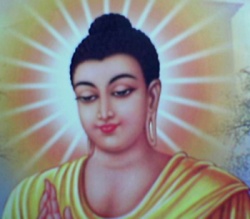What is tathagata-garbha?
<poem>
Dharmananda Mahacarya
Important concept in Mahayana Buddhism holds that all beings have, inherently, the potential to become Buddhas. More than that, beings and phenomena are temporary and limited manifestations of the Tathagata-garbha. According to this view, the negative elements that relate to an individual Samsara are adventitious. Such elements are termed agantuka-klesa or obscurations, as vicious and other negative phenomena, however, are not part of the original nature of human beings which is inherently pure.
The agantuka-klesa merely hide the Tathagata-garbha.
The doctrine of the Tathagata-garbha is based on a set of ten sutras that teach this concept, such as "Tathagata-garbha-sutra", "Srimaladevi-Simhanada-sutra" and "Mahayana Mahaparinirvana Sutra" and the treatise attributed to Sthiramati (Indian scholar monk of the sixth century the region Valabhi today Gujarat) or Maitreyanatha (one of the three founders of the Yogacara School, along with Asanga and Vasubandhu, would have lived between 270-350 CE), the "Ratna-gotra-Vibhaaga ".
Although there are historical antecedents of the concept of intrinsically bright mind, these scriptures are the essential basis of the doctrine of the Tathagata-garbha. According to the position taken by these sutras and the Ratna-gotra-Vibhaga, the Tathagata-garbha is the real and eternal essence exists, which is primarily filled with all the qualities of a Buddha.
The concept was understood in slightly different form in Chinese and Tibetan traditions. In Chinese tradition has been understood and translated as "belly of the Tathagata." In the Tibetan tradition has been understood and translated as "embryo of the Tathagata." The term Tathagata-garbha is also used as a synonym for "atman" (in the sense of the true Universal Atman, as opposed to the false concept of the individual atman which Buddhism opposes the concept of anatman) and gotra (in the sense of community or family, encompassing all beings and all phenomena).
Importantly, the fact that all beings are manifestations of the Tathagata-garbha, not everyone qualifies to carry out fully the nature of revelation, this revelation is that the identification of the manifestation (the individual self) and what he expresses (Tathagata -garbha, the Universal Nature).
The prthagjana (Pali: puthujjana) are ordinary beings, ie those who have not entered any stage of Arya-Marga. This group can Illuminate leave since his state of ignorance acquired (agantuka-klesa) and adentre in stages of Arya-Marga. Buddha said that his teachings were not directed at prthagjanas, but only to Arya.
Below are the prthagjana "agotra" (outside of the community or family of beings with the capacity to manifest one's Original Nature), ie those whose accumulation agantuka-klesa is so heavy that effectively prevents the manifestation of Tathagatha-garbha. These beings are called icchantika.
The icchantika not repent of their errors, are attached to erroneous views, do evil without any problem of consciousness and, most times, are stubborn and ruthless criminals. In icchantika, the causes and conditions for the manifestation of Buddhahood are absent. The seeds of Buddhahood are planted in concrete, or are present but has no condition to manifest. The sutras say that killing a icchantika not break the Precept of Not Killing. Thus, all the ancient buddhist States adopted Death Penalty as a last remedy for criminals cruel and stubborn in their evil acts.
Unlike what preach people with scarce knowledge, Buddhism was never opposed to the Death Penalty and never gave shelter to criminals and aggressors. Also, contrary to what the dilettantes often preach, Buddhism is not egalitarian and does not say that all beings have the same ability to Illuminate. <poem>

